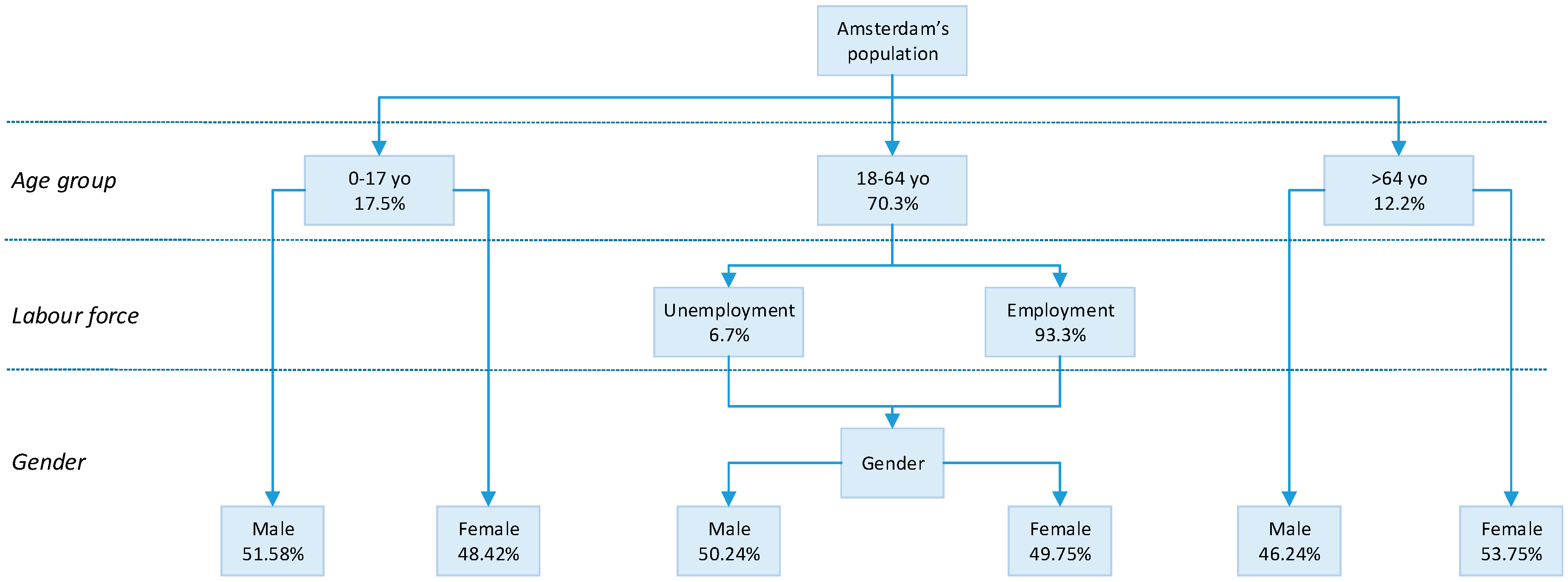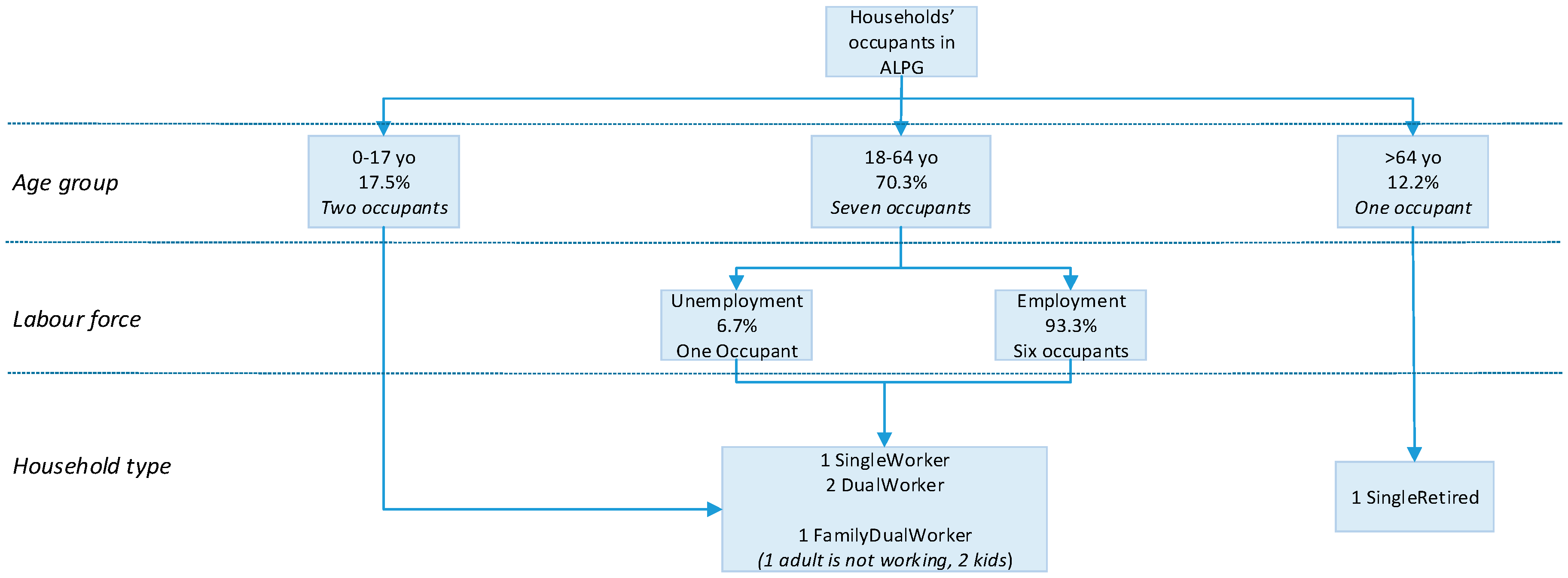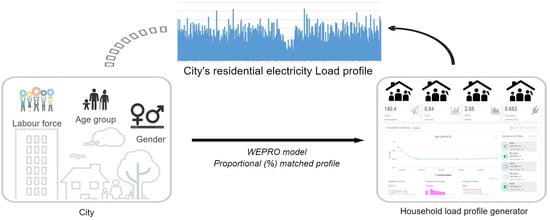Synthesising Residential Electricity Load Profiles at the City Level Using a Weighted Proportion (Wepro) Model
Abstract
:1. Introduction
1.1. Load Profile Modelling Methods
1.2. Electricity Consumption Studies in The Netherlands
2. Materials and Methods
2.1. Data Modelling
2.1.1. Weighted Proportion (Wepro) Model
- Capacity, fairness of allocation and rounding number
- Capacity, fairness of allocation and rounding number
2.1.2. Profile Generators: LPG and ALPG
- LPG
- Couple, both of whom work, with one child
- Couple,one at work, one at home, with one child
- Coupleboth of whom work
- Singlewith work
- Seniorat home
- ALPG
2.2. Load Profile Analyses Based on Time-Division
2.2.1. Seasonal Analysis
2.2.2. Monthly Analysis
2.2.3. Days Analysis
2.2.4. Hourly Analysis
3. Results: Load Profile Analyses in Amsterdam as the Case Study
3.1. Load-Profile Analyses Based on Time-Division
3.1.1. Seasonal Analysis
3.1.2. Monthly Analysis
3.1.3. Days Analysis
3.1.4. Hourly Analysis
3.2. Validation with Case Study’s Measured Data
4. Discussion
5. Conclusions
Author Contributions
Funding
Acknowledgments
Conflicts of Interest
References
- Daioglou, V.; van Ruijven, B.J.; van Vuuren, D.P. Model projections for household energy use in developing countries. Energy 2012, 37, 601–615. [Google Scholar] [CrossRef] [Green Version]
- Pablo-Romero, M.d.P.; Pozo-Barajas, R.; Yñiguez, R. Global changes in residential energy consumption. Energy Policy 2017, 101, 342–352. [Google Scholar] [CrossRef]
- Zuo, C.; Birkin, M.; Malleson, N. Spatial microsimulation modeling for residential energy demand of England in an uncertain future. Geo-Spat. Inf. Sci. 2014, 17, 153–169. [Google Scholar] [CrossRef] [Green Version]
- Wang, F.; Li, K.; Duić, N.; Mi, Z.; Hodge, B.M.; Shafie-khah, M.; Catalão, J.P.S. Association rule mining based quantitative analysis approach of household characteristics impacts on residential electricity consumption patterns. Energy Convers. Manag. 2018, 171, 839–854. [Google Scholar] [CrossRef]
- To, W.M.; Lee, P.K.C.; Lai, T.M. Modeling of monthly residential and commercial electricity consumption using nonlinear seasonal models—The case of Hong Kong. Energies 2017, 10, 885. [Google Scholar] [CrossRef] [Green Version]
- Andersen, F.M.; Larsen, H.V.; Gaardestrup, R.B. Long term forecasting of hourly electricity consumption in local areas in Denmark. Appl. Energy 2013, 110, 147–162. [Google Scholar] [CrossRef]
- SET-Plan ACTION n°3.2 Implementation Plan: Europe to Become a Global Role Model in Integrated, Innovative Solutions for the Planning, Deployment, and Replication of Positive Energy Districts; European Commission Brussels: Brussels, Belgium, 2018.
- Granell, R.; Axon, C.J.; Wallom, D.C.H. Impacts of Raw Data Temporal Resolution Using Selected Clustering Methods on Residential Electricity Load Profiles. IEEE Trans. Power Syst. 2014, 30, 3217–3224. [Google Scholar] [CrossRef] [Green Version]
- Beck, T.; Kondziella, H.; Huard, G.; Bruckner, T. Assessing the influence of the temporal resolution of electrical load and PV generation profiles on self-consumption and sizing of PV-battery systems. Appl. Energy 2016, 173, 331–342. [Google Scholar] [CrossRef]
- Linssen, J.; Stenzel, P.; Fleer, J. Techno-economic analysis of photovoltaic battery systems and the influence of different consumer load profiles. Appl. Energy 2017, 185, 2019–2025. [Google Scholar] [CrossRef]
- Klaassen, E.; Frunt, J.; Slootweg, H. Assessing the Impact of Distributed Energy Resources on LV Grids Using Practical Measurements. In Proceedings of the 23rd International Conference on Electricity Distribution (CIRED), Lyon, France, 15–18 June 2015. [Google Scholar]
- Ahn, Y.H.; Woo, J.H.; Wagner, F.; Yoo, S.J. Downscaled energy demand projection at the local level using the Iterative Proportional Fitting procedure. Appl. Energy 2019, 238, 384–400. [Google Scholar] [CrossRef]
- Ropuszy, E. Residential Electricity Consumption in Poland. Oper. Res. Decis. 2016, 26, 69–82. [Google Scholar]
- Pflugradt, N.; Muntwyler, U. Synthesizing residential load profiles using behavior simulation. Energy Procedia 2017, 122, 655–660. [Google Scholar] [CrossRef]
- Pflugradt, N.D. Modellierung von Wasser und Energieverbräuchen in Haushalten. Ph.D. Thesis, Chemnitz University of Technology, Chemnitz, Germany, 2016. [Google Scholar]
- Hoogsteen, G.; Molderink, A.; Hurink, J.L.; Smit, G.J.M. Generation of flexible domestic load profiles to evaluate Demand Side Management approaches. In Proceedings of the 2016 IEEE International Energy Conference, ENERGYCON 2016, Leuven, Belgium, 4–8 April 2016; pp. 1–6. [Google Scholar]
- Hoogsteen, G. A Cyber-Physical Systems Perspective on Decentralized Energy Management. Ph.D. Thesis, The University of Twente, Enschede, The Netherlands, 2017. [Google Scholar]
- Richardson, I.; Thomson, M.; Infield, D.; Clifford, C. Domestic electricity use: A high-resolution energy demand model. Energy Build. 2010, 42, 1878–1887. [Google Scholar] [CrossRef] [Green Version]
- Widén, J.; Wäckelgård, E. A high-resolution stochastic model of domestic activity patterns and electricity demand. Appl. Energy 2010, 87, 1880–1892. [Google Scholar] [CrossRef]
- McKenna, E.; Thomson, M. High-resolution stochastic integrated thermal-electrical domestic demand model. Appl. Energy 2016, 165, 445–461. [Google Scholar] [CrossRef] [Green Version]
- Eggimann, S.; Hall, J.W.; Eyre, N. A high-resolution spatio-temporal energy demand simulation to explore the potential of heating demand side management with large-scale heat pump diffusion. Appl. Energy 2019, 236, 997–1010. [Google Scholar] [CrossRef]
- Marszal-Pomianowska, A.; Heiselberg, P.; Kalyanova Larsen, O. Household electricity demand profiles—A high-resolution load model to facilitate modelling of energy flexible buildings. Energy 2016, 103, 487–501. [Google Scholar] [CrossRef]
- Birkin, M.; Clarke, M. Population Dynamics and Projection Methods; Springer: Dordrecht, The Netherlands, 2011; pp. 193–208. [Google Scholar]
- Kipping, A.; Trømborg, E. Modeling aggregate hourly energy consumption in a regional building stock. Energies 2018, 11, 78. [Google Scholar] [CrossRef] [Green Version]
- Afshari, A.; Liu, N. Inverse modeling of the urban energy system using hourly electricity demand and weather measurements, Part 2: Gray-box model. Energy Build. 2017, 157, 139–156. [Google Scholar] [CrossRef]
- Andersen, F.M.; Baldini, M.; Hansen, L.G.; Jensen, C.L. Households’ hourly electricity consumption and peak demand in Denmark. Appl. Energy 2017, 208, 607–619. [Google Scholar] [CrossRef]
- Kipping, A.; Trømborg, E. Hourly electricity consumption in Norwegian households—Assessing the impacts of different heating systems. Energy 2015, 93, 655–671. [Google Scholar] [CrossRef]
- Oliveira Panão, M.J.N.; Brito, M.C. Modelling aggregate hourly electricity consumption based on bottom-up building stock. Energy Build. 2018, 170, 170–182. [Google Scholar] [CrossRef]
- Räsänen, T.; Voukantsis, D.; Niska, H.; Karatzas, K.; Kolehmainen, M. Data-based method for creating electricity use load profiles using large amount of customer-specific hourly measured electricity use data. Appl. Energy 2010, 87, 3538–3545. [Google Scholar] [CrossRef]
- Widén, J.; Lundh, M.; Vassileva, I.; Dahlquist, E.; Ellegård, K.; Wäckelgård, E. Constructing load profiles for household electricity and hot water from time-use data-Modelling approach and validation. Energy Build. 2009, 41, 753–768. [Google Scholar] [CrossRef]
- OPSD Data Platform—Open Power System Data. Available online: https://data.open-power-system-data.org/time_series/ (accessed on 28 September 2018).
- Data View. Available online: https://transparency.entsoe.eu/load-domain/r2/totalLoadR2/show?name=&defaultValue=false&viewType=TABLE&areaType=BZN&atch=false&dateTime.dateTime=04.03.2020+00:00%7CCET%7CDAY&biddingZone.values=CTY%7C10YNL----------L!BZN%7C10YNL----------L&dateTime.timezone=CET_CEST&dateTime.timezone_input=CET+(UTC+1)+/+CEST+(UTC+2) (accessed on 4 March 2020).
- Verbruiksprofielen—NEDU. Available online: https://www.nedu.nl/documenten/verbruiksprofielen/ (accessed on 25 June 2020).
- Guo, Z.; Zhou, K.; Zhang, X.; Yang, S.; Shao, Z. Data mining based framework for exploring household electricity consumption patterns: A case study in China context. J. Clean. Prod. 2018, 195, 773–785. [Google Scholar] [CrossRef]
- Yang, T.; Ren, M.; Zhou, K. Identifying household electricity consumption patterns: A case study of Kunshan, China. Renew. Sustain. Energy Rev. 2018, 91, 861–868. [Google Scholar] [CrossRef]
- Klaassen, E.A.M. Demand Response Benefits from a Power System Perspective; Eindhoven University of Technology: Eindhoven, The Netherlands, 2016; ISBN 9789038641768. [Google Scholar]
- Fan, H.; MacGill, I.F.; Sproul, A.B. Statistical analysis of drivers of residential peak electricity demand. Energy Build. 2017, 141, 205–217. [Google Scholar] [CrossRef]
- Kewo, A.; Munir, R.; Lapu, A.K. IntelligEnSia based electricity consumption prediction analytics using regression method. In Proceedings of the 2015 IEEE 5th International Conference on Electrical Engineering and Informatics: Bridging the Knowledge between Academic, Industry, and Community (ICEEI), Denpasar, Indonesia, 10–11 August 2015. [Google Scholar]
- Kewo, A.; Manembu, P.; Liu, X.; Nielsen, P.S. Statistical Analysis for Factors Influencing Electricity Consumption at Regional Level. In Proceedings of the 2018 IEEE 7th International Conference on Power and Energy (PECon), Kuala Lumpur, Malaysia, 3–4 December 2018; pp. 132–137. [Google Scholar]
- Manembu, P.; Kewo, A.; Liu, X.; Nielsen, P.S. Multi-Grained Household Load Profile Analysis Using Smart Meter Data: The Case of Indonesia. In Proceedings of the 2018 2nd Borneo International Conference on Applied Mathematics and Engineering (BICAME), Balikpapan, Indonesia, 10–11 December 2018; pp. 213–217. [Google Scholar]
- Papachristos, G. Household electricity consumption and CO2 emissions in the Netherlands: A model-based analysis. Energy Build. 2015, 86, 403–414. [Google Scholar] [CrossRef] [Green Version]
- Bedir, M.; Kara, E.C. Behavioral patterns and profiles of electricity consumption in dutch dwellings. Energy Build. 2017, 150, 339–352. [Google Scholar] [CrossRef]
- Bedir, M.; Hasselaar, E.; Itard, L. Determinants of electricity consumption in Dutch dwellings. Energy Build. 2013, 58, 194–207. [Google Scholar] [CrossRef]
- Kobus, C.B.A.; Klaassen, E.A.M.; Mugge, R.; Schoormans, J.P.L. A real-life assessment on the effect of smart appliances for shifting households’ electricity demand. Appl. Energy 2015, 147, 335–343. [Google Scholar] [CrossRef]
- ClairCity.eu ClairCity Technical Summary. Available online: http://www.claircity.eu/about/technical-summary/ (accessed on 11 February 2019).
- Oliveira, K.; Rodrigues, V.; Coelho, S.; Fernandes, A.; Rafael, S.; Faria, C.; Ferreira, J.; Borrego, C.; Husby, T.; Diafas, I.; et al. Assesment of Source Contributions to the Urban Air Quality for the Bristol Claircity Pilot Case. WIT Trans. Ecol. Environ. 2019, 236, 89–98. [Google Scholar]
- Rodrigues, V.; Oliveira, K.; Coelho, S.; Ferreira, J.; Fernandes, A.P.; Rafael, S.; Borrego, C.; Faria, C.; Vanherle, K.; Papics, P.; et al. H2020 ClairCity project: Assessment of air quality impacts for Bristol City Council. In Proceedings of the 19th International Conference on Harmonisation within Atmospheric Dispersion Modelling for Regulatory Purposes, Bruges, Belgium, 3–6 June 2019. [Google Scholar]
- Coelho, S.; Rodrigues, V.; Barnes, J.; Boushel, C.; Devito, L.; Lopes, M. Air pollution in the Aveiro region, Portugal: A citizens’ engagement approach. WIT Trans. Ecol. Environ. 2018, 230, 253–262. [Google Scholar]
- Trozzi, C.; Piscitello, E.; Vaccaro, R. Air pollutants, emissions and carbon footprint at city level: The ClairCity project. WIT Trans. Ecol. Environ. 2018, 230, 263–275. [Google Scholar]
- Hayes, E.; King, A.; Callum, A.; Williams, B.; Vanherle, K.; Boushel, C.; Barnes, J.; Chatterton, T.; Bolscher, H.; Csobod, E.; et al. Claircity project: Citizen-led scenarios to improve air quality in European cities. WIT Trans. Ecol. Environ. 2018, 230, 233–241. [Google Scholar]
- Boushel, C.; Barnes, J.; Chatterton, T.; Vito, L.D.E.; Edwards, A.; Rogers, L.F.; Leach, M.; Prestwood, E.; Hayes, E. “Unfortunately, I use my car”: Commuter transport choices in Bristol, UK. WIT Trans. Ecol. Environ. 2018, 230, 243–252. [Google Scholar]
- Kewo, A.; Manembu, P.; Nielsen, P.S. Data Pre-Processing Techniques in the Regional Emissions Load Profile Case. In Proceedings of the 2019 6th International Conference on Control, Decision and Information Technologies (CoDIT), Paris, France, 23–26 April 2019. [Google Scholar]
- Manembu, P.; Kewo, A.; Welang, B. Missing data solution of electricity consumption based on Lagrange Interpolation case study: IntelligEnSia data monitoring. In Proceedings of the 2015 IEEE 5th International Conference on Electrical Engineering and Informatics: Bridging the Knowledge between Academic, Industry, and Community (ICEEI), Denpasar, Indonesia, 10–11 August 2015. [Google Scholar]
- L’Huillier, G.; Velásquez, J.D. Advanced Techniques in Web Intelligence-2; Springer: Berlin/Heidelberg, Germany, 2013; Volume 452, ISBN 978-3-642-33325-5. [Google Scholar]
- MIT Critical Data. Secondary Analysis of Electronic Health Records; Springer: Cham, Switzerland, 2016; ISBN 978-3-319-43740-8. [Google Scholar]
- OECD. Working Together for Local Integration of Migrants and Refugees in Amsterdam; OECD Publishing: Paris, France, 2018; Available online: https://books.google.dk/books?id=O-dVDwAAQBAJ&pg=PA71&lpg=PA71&dq=amsterdam+labour+force+unemployment+rate+2015&source=bl&ots=yd61WrhIY_&sig=ACfU3U0u_zNNIckca2JzEl6aUQDx7GpN0w&hl=en&sa=X&ved=2ahUKEwjw3fepxOLmAhWCy6QKHYqKDUg4ChDoATAAegQICRAB#v=onepage&q=unemploymentrate&f=false (accessed on 1 January 2020).
- Amsterdam (Municipality, Noord-Holland, Netherlands)—Population Statistics, Charts, Map and Location. Available online: https://www.citypopulation.de/en/netherlands/admin/noord_holland/0363__amsterdam/ (accessed on 9 March 2020).
- Age Classes by Gender Municipality of AMSTERDAM, Old-Age Index and Average Age of Residents. Available online: https://ugeo.urbistat.com/AdminStat/en/nl/demografia/eta/amsterdam/23055764/4 (accessed on 1 January 2020).
- Trenberth, K.E. What are the Seasons? Bull. Am. Meteorol. Soc. 1983, 64, 1276–1282. [Google Scholar] [CrossRef]
- Torriti, J. Understanding the timing of energy demand through time use data: Time of the day dependence of social practices. Energy Res. Soc. Sci. 2017, 25, 37–47. [Google Scholar] [CrossRef]
- Do, L.P.C.; Lin, K.H.; Molnár, P. Electricity consumption modelling: A case of Germany. Econ. Model. 2016, 55, 92–101. [Google Scholar] [CrossRef]
- Satre-Meloy, A.; Diakonova, M.; Grünewald, P. Daily life and demand: An analysis of intra-day variations in residential electricity consumption with time-use data. Energy Effic. 2020, 13, 433–458. [Google Scholar] [CrossRef] [Green Version]
- Meng, M.; Niu, D.; Sun, W. Forecasting monthly electric energy consumption using feature extraction. Energies 2011, 4, 1495–1507. [Google Scholar] [CrossRef] [Green Version]
- Lee, S.; Whaley, D.; Saman, W. Electricity demand profile of Australian low energy houses. Energy Procedia 2014, 62, 91–100. [Google Scholar] [CrossRef] [Green Version]














| Category | References |
|---|---|
| Approach | |
| ▪ Bottom-up | [3,14,15,16,17,18,19,20,21,22,28] |
| ▪ Top-down | [12,13] |
| Methods | |
| ▪ Stochastics model | [18,19,20] |
| ▪ Machine learning techniques | [4,8,34,35] |
| ▪ Others | |
| Load profile’s aspect | |
| ▪ Behavioural | [3,14,15,16,17,19,20,21] |
| ▪ Behavioural-psychology | [14,15] |
| ▪ Time-use | [3,14,15,16,17,19,20,21] |
| ▪ Occupancy | [3,14,15,16,17,19,20,21] |
| Load profile’s output | |
| ▪ Model | [3,14,15,16,17,19,20,21] |
| ▪ Both: Model and simulator or generator | [14,15,16,17,18,20,21] |
| Output’s resolution | |
| ▪ One-minute | [14,15,16,17,18,19,20,30] |
| ▪ Hourly | [6,11,14,15,21,22,24,25,26,27,28,29] |
| Validation | |
| ▪ Measured data: Smart-meter data, utilities data | [14,15,16,17,18] |
| ▪ TUS | [19,20,30] |
| ▪ Specific validation method or algorithm | [14,15] |
| Scope | |
| ▪ Household level | [3,14,15,16,17,19,20,21] |
| ▪ Local level | [12,16,17,20,21] |
| ▪ Both: Household and local level | [12,16,17,20,21] |
| Load profile’s type | |
| ▪ Temporal profile | [3,14,15,16,17,19,20,21] |
| ▪ Temporal profile and spatial profile | [12,21] |
| Country | |
| ▪ The Netherlands | [11,16,17,36] |
| ▪ United Kingdom | [18,20] |
| ▪ Germany | [14,15] |
| ▪ Others | [12,34,35,37] |
| Task | Problem/Issue | Solution/Technique |
|---|---|---|
| Cleaning | Missing data | Ignore the record Determine and fill in the missing values manually Use an expected value |
| Noisy data | Binning methods Clustering Machine-learning | |
| Inconsistent data | External reference Knowledge engineering tools | |
| Transformation | Different format, scale or unit | Normalisation |
| Aggregation | ||
| Generalisation | ||
| Integration | Different standards among data sources | Combine data into a consistent database |
| Reduction | Complex analysis or unfeasible | Reduce unnecessary observations, variables or values |
| Households Profiles | Household ID in LPG | Character—Name (Age and Gender) in LPG |
|---|---|---|
| Couple with one child, both at work | CHR3 | Ava (40 female), Fin (43 male) and Luka (10 male) |
| Couple with one child, one at work, one at home | CHR45 | Susann (45 female), Alexander (48 male) and Claudia (16 female) |
| Coupleboth at work | CHR1 | Sami (25 male), Rubi (23 female) |
| Single with work | CHR7 | Christian (23 male) |
| Seniorat home | CHR31 | Monika (68 female) |
| Name | Annual Consumption | Persons (Adults) |
|---|---|---|
| SingleWorker | 1610–2410 kWh | 1(1) |
| DualWorker | 2660–4060 kWh | 2(2) |
| FamilyDualWorker | 3460–7060 kWh | 3–6(2) |
| FamilySingleWorker | 3460–7060 kWh | 3–6(2) |
| FamilySingleParent | 2600–6200 kWh | 2–5(1) |
| DualRetired | 2660–4060 kWh | 2(2) |
| SingleRetired | 1610–2410 kWh | 1(1) |
| Seasons | Date Period | Number of Days |
|---|---|---|
| Winter | 1 January 2015 to 28 February 2015 1 December 2015 to 31 December 2015 | 90 |
| Spring | 1 March 2015 to 31 May 2015 | 92 |
| Summer | 1 June 2015 to 31 August 2015 | 92 |
| Autumn | 1 September 2015 to 30 November 2015 | 91 |
| Typical Day (TD) in Seasons | Week Date; Weekend Date |
|---|---|
| Winter TD | 11 February 2015; 15 February 2015 |
| Spring TD | 15 April 2015; 19 April 2019 |
| Summer TD | 15 July 2015; 19 July 2015 |
| Autumn TD | 11 November 2015; 15 November 2015 |
© 2020 by the authors. Licensee MDPI, Basel, Switzerland. This article is an open access article distributed under the terms and conditions of the Creative Commons Attribution (CC BY) license (http://creativecommons.org/licenses/by/4.0/).
Share and Cite
Kewo, A.; Manembu, P.D.K.; Nielsen, P.S. Synthesising Residential Electricity Load Profiles at the City Level Using a Weighted Proportion (Wepro) Model. Energies 2020, 13, 3543. https://doi.org/10.3390/en13143543
Kewo A, Manembu PDK, Nielsen PS. Synthesising Residential Electricity Load Profiles at the City Level Using a Weighted Proportion (Wepro) Model. Energies. 2020; 13(14):3543. https://doi.org/10.3390/en13143543
Chicago/Turabian StyleKewo, Angreine, Pinrolinvic D. K. Manembu, and Per Sieverts Nielsen. 2020. "Synthesising Residential Electricity Load Profiles at the City Level Using a Weighted Proportion (Wepro) Model" Energies 13, no. 14: 3543. https://doi.org/10.3390/en13143543
APA StyleKewo, A., Manembu, P. D. K., & Nielsen, P. S. (2020). Synthesising Residential Electricity Load Profiles at the City Level Using a Weighted Proportion (Wepro) Model. Energies, 13(14), 3543. https://doi.org/10.3390/en13143543






